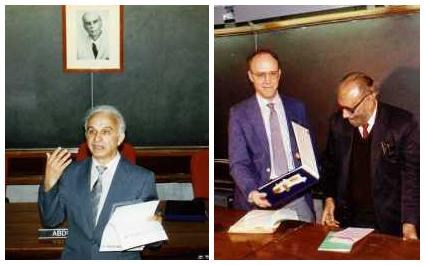Efim S. Fradkin (1924-1999)
Lebedev Physical Institute, Moscow, Russian Federation
for his many fruitful contributions to the development of quantum field theory and statistics. Among these are his early work on functional methods including his formal solution to the Schwinger-Dyson equations for the Green's functions of interacting systems. This result has become a standard part of modern quantum field theory. Independently of Takahashi he discovered the generalized Ward identities for electrodynamics. These identities and their generalizations for non-Abelian gauge theories are basic to the understanding of local symmetries. In his work on the Schwinger-Dyson equations, Fradkin drew attention to the zero-charge problem, a potential inconsistency in Abelian gauge theories whose later resolution in the non-Abelian theories led to the discovery of asymptotic freedom. At the same time as Schwinger and Nakano, Fradkin constructed a Euclidean formulation of quantum field theory, a development which was to have far-reaching implications for the development of statistical physics and string theory. His contributions to the quantization of relativistic systems with constraints are widely recognized. This work culminated in the Batalin-Fradkin-Wilkovisky quantization method which is used both in quantum field theory and in the theory of extended objects such as strings and membranes.
David J. Gross, Princeton University, Princeton, USA (at the time of the award)
for his fundamental contributions to the understanding of nuclear forces at short distances and to the theory of superstrings. Together with F. Wilczek and, independently, H.D. Politzer and G.H. 't Hooft, he discovered the mechanism of asymptotic freedom in non-Abelian gauge theories. This discovery, which accounts for the phenomenon of scaling in deep inelastic interactions, was central to the development of quantum chromodynamics as a viable model for the nuclear force. His invention, together with Harvey, Martinec and Rohm, of the heterotic superstring model enlarges the theoretical understanding of string theory and has provided a great stimulus to research in this subject. By its bold generalization from the picture of the relativistic string as a geometrical object embedded in spacetime, the heterotic model, seen as a two-dimensional conformal field theory whose left and right-moving modes are qualitatively different, is able to account for chirality in particle physics. This opened the way for a new understanding of the nature of spacetime and the unification of elementary forces.

















